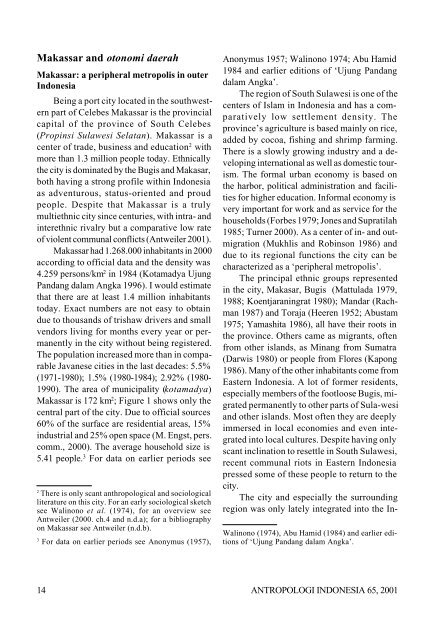Transethnic Identity and Urban Cognition in Makassar: - Antropologi ...
Transethnic Identity and Urban Cognition in Makassar: - Antropologi ...
Transethnic Identity and Urban Cognition in Makassar: - Antropologi ...
You also want an ePaper? Increase the reach of your titles
YUMPU automatically turns print PDFs into web optimized ePapers that Google loves.
<strong>Makassar</strong> <strong>and</strong> otonomi daerah<br />
<strong>Makassar</strong>: a peripheral metropolis <strong>in</strong> outer<br />
Indonesia<br />
Be<strong>in</strong>g a port city located <strong>in</strong> the southwestern<br />
part of Celebes <strong>Makassar</strong> is the prov<strong>in</strong>cial<br />
capital of the prov<strong>in</strong>ce of South Celebes<br />
(Prop<strong>in</strong>si Sulawesi Selatan). <strong>Makassar</strong> is a<br />
center of trade, bus<strong>in</strong>ess <strong>and</strong> education 2 with<br />
more than 1.3 million people today. Ethnically<br />
the city is dom<strong>in</strong>ated by the Bugis <strong>and</strong> Makasar,<br />
both hav<strong>in</strong>g a strong profile with<strong>in</strong> Indonesia<br />
as adventurous, status-oriented <strong>and</strong> proud<br />
people. Despite that <strong>Makassar</strong> is a truly<br />
multiethnic city s<strong>in</strong>ce centuries, with <strong>in</strong>tra- <strong>and</strong><br />
<strong>in</strong>terethnic rivalry but a comparative low rate<br />
of violent communal conflicts (Antweiler 2001).<br />
<strong>Makassar</strong> had 1.268.000 <strong>in</strong>habitants <strong>in</strong> 2000<br />
accord<strong>in</strong>g to official data <strong>and</strong> the density was<br />
4.259 persons/km 2 <strong>in</strong> 1984 (Kotamadya Ujung<br />
P<strong>and</strong>ang dalam Angka 1996). I would estimate<br />
that there are at least 1.4 million <strong>in</strong>habitants<br />
today. Exact numbers are not easy to obta<strong>in</strong><br />
due to thous<strong>and</strong>s of trishaw drivers <strong>and</strong> small<br />
vendors liv<strong>in</strong>g for months every year or permanently<br />
<strong>in</strong> the city without be<strong>in</strong>g registered.<br />
The population <strong>in</strong>creased more than <strong>in</strong> comparable<br />
Javanese cities <strong>in</strong> the last decades: 5.5%<br />
(1971-1980); 1.5% (1980-1984); 2.92% (1980-<br />
1990). The area of municipality (kotamadya)<br />
<strong>Makassar</strong> is 172 km 2 ; Figure 1 shows only the<br />
central part of the city. Due to official sources<br />
60% of the surface are residential areas, 15%<br />
<strong>in</strong>dustrial <strong>and</strong> 25% open space (M. Engst, pers.<br />
comm., 2000). The average household size is<br />
5.41 people. 3 For data on earlier periods see<br />
2 There is only scant anthropological <strong>and</strong> sociological<br />
literature on this city. For an early sociological sketch<br />
see Wal<strong>in</strong>ono et al. (1974), for an overview see<br />
Antweiler (2000. ch.4 <strong>and</strong> n.d.a); for a bibliography<br />
on <strong>Makassar</strong> see Antweiler (n.d.b).<br />
3 For data on earlier periods see Anonymus (1957),<br />
Anonymus 1957; Wal<strong>in</strong>ono 1974; Abu Hamid<br />
1984 <strong>and</strong> earlier editions of ‘Ujung P<strong>and</strong>ang<br />
dalam Angka’.<br />
The region of South Sulawesi is one of the<br />
centers of Islam <strong>in</strong> Indonesia <strong>and</strong> has a comparatively<br />
low settlement density. The<br />
prov<strong>in</strong>ce’s agriculture is based ma<strong>in</strong>ly on rice,<br />
added by cocoa, fish<strong>in</strong>g <strong>and</strong> shrimp farm<strong>in</strong>g.<br />
There is a slowly grow<strong>in</strong>g <strong>in</strong>dustry <strong>and</strong> a develop<strong>in</strong>g<br />
<strong>in</strong>ternational as well as domestic tourism.<br />
The formal urban economy is based on<br />
the harbor, political adm<strong>in</strong>istration <strong>and</strong> facilities<br />
for higher education. Informal economy is<br />
very important for work <strong>and</strong> as service for the<br />
households (Forbes 1979; Jones <strong>and</strong> Supratilah<br />
1985; Turner 2000). As a center of <strong>in</strong>- <strong>and</strong> outmigration<br />
(Mukhlis <strong>and</strong> Rob<strong>in</strong>son 1986) <strong>and</strong><br />
due to its regional functions the city can be<br />
characterized as a ‘peripheral metropolis’.<br />
The pr<strong>in</strong>cipal ethnic groups represented<br />
<strong>in</strong> the city, Makasar, Bugis (Mattulada 1979,<br />
1988; Koentjaran<strong>in</strong>grat 1980); M<strong>and</strong>ar (Rachman<br />
1987) <strong>and</strong> Toraja (Heeren 1952; Abustam<br />
1975; Yamashita 1986), all have their roots <strong>in</strong><br />
the prov<strong>in</strong>ce. Others came as migrants, often<br />
from other isl<strong>and</strong>s, as M<strong>in</strong>ang from Sumatra<br />
(Darwis 1980) or people from Flores (Kapong<br />
1986). Many of the other <strong>in</strong>habitants come from<br />
Eastern Indonesia. A lot of former residents,<br />
especially members of the footloose Bugis, migrated<br />
permanently to other parts of Sula-wesi<br />
<strong>and</strong> other isl<strong>and</strong>s. Most often they are deeply<br />
immersed <strong>in</strong> local economies <strong>and</strong> even <strong>in</strong>tegrated<br />
<strong>in</strong>to local cultures. Despite hav<strong>in</strong>g only<br />
scant <strong>in</strong>cl<strong>in</strong>ation to resettle <strong>in</strong> South Sulawesi,<br />
recent communal riots <strong>in</strong> Eastern Indonesia<br />
pressed some of these people to return to the<br />
city.<br />
The city <strong>and</strong> especially the surround<strong>in</strong>g<br />
region was only lately <strong>in</strong>tegrated <strong>in</strong>to the In-<br />
Wal<strong>in</strong>ono (1974), Abu Hamid (1984) <strong>and</strong> earlier editions<br />
of ‘Ujung P<strong>and</strong>ang dalam Angka’.<br />
14 ANTROPOLOGI INDONESIA 65, 2001


